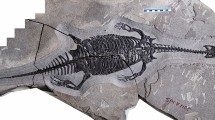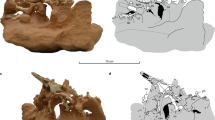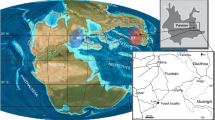Abstract
The modern giant sperm whale Physeter macrocephalus, one of the largest known predators, preys upon cephalopods at great depths1,2. Lacking a functional upper dentition, it relies on suction for catching its prey3; in contrast, several smaller Miocene sperm whales (Physeteroidea) have been interpreted as raptorial (versus suction) feeders4,5, analogous to the modern killer whale Orcinus orca. Whereas very large physeteroid teeth have been discovered in various Miocene localities, associated diagnostic cranial remains have not been found so far6,7,8. Here we report the discovery of a new giant sperm whale from the Middle Miocene of Peru (approximately 12–13 million years ago), Leviathan melvillei, described on the basis of a skull with teeth and mandible. With a 3-m-long head, very large upper and lower teeth (maximum diameter and length of 12 cm and greater than 36 cm, respectively), robust jaws and a temporal fossa considerably larger than in Physeter, this stem physeteroid represents one of the largest raptorial predators and, to our knowledge, the biggest tetrapod bite ever found. The appearance of gigantic raptorial sperm whales in the fossil record coincides with a phase of diversification and size-range increase of the baleen-bearing mysticetes in the Miocene. We propose that Leviathan fed mostly on high-energy content medium-size baleen whales. As a top predator, together with the contemporaneous giant shark Carcharocles megalodon, it probably had a profound impact on the structuring of Miocene marine communities. The development of a vast supracranial basin in Leviathan, extending on the rostrum as in Physeter, might indicate the presence of an enlarged spermaceti organ in the former that is not associated with deep diving or obligatory suction feeding.
This is a preview of subscription content, access via your institution
Access options
Subscribe to this journal
Receive 51 print issues and online access
$199.00 per year
only $3.90 per issue
Buy this article
- Purchase on Springer Link
- Instant access to full article PDF
Prices may be subject to local taxes which are calculated during checkout




Similar content being viewed by others
References
Rice, D. W. in Handbook of Marine Mammals Vol. 56 (eds Ridgway, S. H. & Harrison, R.) 177–233 (Academic, 1989)
Watwood, S. L., Miller, P. J. O., Johnson, M., Madsen, P. T. & Tyack, P. L. Deep-diving behaviour of sperm whales (Physeter macrocephalus). J. Anim. Ecol. 75, 814–825 (2006)
Werth, A. J. Functional anatomy of the sperm whale tongue, with reference to suction feeding. Aquat. Mamm. 30, 405–418 (2004)
Bianucci, G. & Landini, W. Killer sperm whale: a new basal physeteroid (Mammalia, Cetacea) from the Late Miocene of Italy. Zool. J. Linn. Soc. 148, 103–131 (2006)
Lambert, O., Bianucci, G. & de Muizon, C. A new stem-sperm whale (Cetacea, Odontoceti, Physeteroidea) from the latest Miocene of Peru. C. R. Palevol. 7, 361–369 (2008)
Leidy, J. Description of vertebrate remains, chiefly from the phosphate beds of South Carolina. J. Acad. Nat. Sci. Phila. 8, 209–261 (1877)
Abel, O. Les Odontocètes du Boldérien (Miocène supérieur) des environs d’Anvers. Mém. Mus. R. Hist. Nat. Belg. 3, 1–155 (1905)
Kellogg, R. Two fossil physeteroid whales from California. Contr. Paleontol. Carnegie Inst. Wash. 348, 1–34 (1925)
Kato, H. Observation of tooth scars on the head of male sperm whale, as an indication of intra-sexual fighting. Sci. Rep. Whales Res. Inst. 35, 39–46 (1984)
Whitehead, H. Sperm Whales: Social Evolution in the Ocean (Univ. Chicago Press, 2003)
Hirota, K. & Barnes, L. G. A new species of Middle Miocene sperm whale of the genus Scaldicetus (Cetacea; Physeteridae) from Shiga-Mura, Japan. Isl. Arc 3, 453–472 (1996)
Caldwell, D. K. & Caldwell, M. C. in Handbook of Marine Mammals Vol. 4 (eds Ridgway, S. H. & Harrison, R.) 235–260 (Academic, 1989)
Hohn, A. A. in Encyclopedia of Marine Mammals 2nd edn (eds Perrin, W. F., Würsig, B. & Thewissen, J. G. M.) 11–18 (Academic, 2009)
Taylor, M. A. Functional anatomy of the head of the large aquatic predator Rhomaleosaurus zetlandicus (Plesiosauria, Reptilia) from the Toarcian (Lower Jurassic) of Yorkshire, England. Philos. Trans. R. Soc. Lond. B 335, 247–280 (1992)
Dalheim, M. E. & Heyning, J. E. in Handbook of Marine Mammals Vol. 6 (eds Ridgway, S. H. & Harrison, R.) 281–322 (Academic, 1999)
Werth, A. J. in Feeding: Form, Function, and Evolution in Tetrapod Vertebrates (ed. Schwenk, K.) 487–526 (Academic, 2000)
Jefferson, T. A., Stacey, P. J. & Baird, R. W. A review of killer whale interactions with other marine mammals: predation to co-existence. Mammal Rev. 21, 151–180 (1991)
Reeves, R. R., Berger, J. & Clapham, P. J. in Whales, Whaling, and Ocean Ecosystems (eds Estes J. A. et al.) 174–187 (Univ. California Press, 2006)
Brand, L. R., Esperante, R., Chadwick, A. V., Pomas, O. & Alomía, M. Fossil whale preservation implies high diatom accumulation rate in the Miocene–Pliocene Pisco Formation of Peru. Geology 32, 165–168 (2004)
Uhen, M. D. & Pyenson, N. D. Diversity estimates, biases, and historiographic effects: resolving cetacean diversity in the Tertiary. Palaeontol. Electronica 10, 11–22 (2007)
Marx, F. G. Marine mammals through time: when less is more in studying palaeodiversity. Proc. R. Soc. Lond. B 276, 887–892 (2009)
Lindberg, D. R. & Pyenson, N. D. in Whales, Whaling, and Ocean Ecosystems (eds Estes J. A. et al.) 67–81 (Univ. California Press, 2006)
Fordyce, R. E. & de Muizon, C. in Secondary Adaptation of Tetrapods to Life in Water (eds Mazin, J.-M. & de Buffrénil, V.) 169–233 (Dr. Friedrich Pfeil, 2001)
Hone, D. W. E. & Benton, M. J. The evolution of large size: how does Cope's Rule work? Trends Ecol. Evol. 20, 4–6 (2005)
Purdy, R. 1996. in Great White Sharks: the Biology of Carcharodon carcharias (eds Klimley, A. P. & Ainley D. G.) 67–78 (Academic, 1996)
Williams, T. M., Estes, J. A., Doak, D. F. & Springer, A. M. Killer appetites: assessing the role of predators in ecological communities. Ecology 85, 3373–3384 (2004)
Springer, A. M. et al. Sequential megafaunal collapse in the North Pacific Ocean: an ongoing legacy of industrial whaling. Proc. Natl Acad. Sci. USA 100, 12223–12228 (2003)
Cranford, T. W. The sperm whale's nose: sexual selection on a grand scale? Mar. Mamm. Sci. 15, 1133–1157 (1999)
Carrier, D. R., Deban, S. M. & Otterstrom, J. The face that sank the Essex: potential function of the spermaceti organ in aggression. J. Exp. Biol. 205, 1755–1763 (2002)
Zachos, J., Pagani, M., Sloan, L., Thomas, E. & Billups, K. Trends, rhythms, and aberrations in global climate 65 Ma to present. Science 292, 686–693 (2001)
Acknowledgements
We thank W. Aguirre, A. Altamirano, E. Díaz, A. Martínez and N. Valencia for assistance during fieldwork and preparation of the specimen; C. Letenneur for the reconstruction of Leviathan; P. Loubry for the photo of the tooth of Orcinus; D. J. Bohaska, G. Lenglet, J. G. Mead, C. Potter, H. van der Es, R. van Zelst and A. Varola for access to collections; M. D. Uhen for his compilation of cetacean data in The Paleobiology Database, and the Board of the Natuurhistorisch Museum Rotterdam Foundation for financial support of our research on fossil cetaceans in Peru. The work of O.L. at IRSNB was funded by the Belgian Federal Science Policy Office.
Author information
Authors and Affiliations
Contributions
O.L., G.B., K.P., M.U., R.S.-G. and J.R. took part in the fieldwork. R.S.-G. and M.U. organized the rescue and preparation of the specimen. O.L., G.B., K.P., C.M. and J.R. carried out the interpretation of the specimen. O.L. and G.B. undertook the phylogenetic analysis. G.B., O.L., K.P. and R.S.-G. collected the data on the size of mysticetes. G.B. undertook the statistical analyses and prepared the illustrations. O.L. wrote the paper. G.B., K.P., C.M. and J.R. discussed the results and commented on the manuscript at all stages.
Corresponding authors
Ethics declarations
Competing interests
The authors declare no competing financial interests.
Supplementary information
Supplementary Information
This file contains Supplementary Information, Supplementary Figures 1 - 10 with legends, Supplementary Tables 1 - 10 and References. (PDF 17674 kb)
Rights and permissions
About this article
Cite this article
Lambert, O., Bianucci, G., Post, K. et al. The giant bite of a new raptorial sperm whale from the Miocene epoch of Peru. Nature 466, 105–108 (2010). https://doi.org/10.1038/nature09067
Received:
Accepted:
Issue Date:
DOI: https://doi.org/10.1038/nature09067
This article is cited by
-
Patterns of enrichment and acceleration in evolutionary rates of promoters suggest a role of regulatory regions in cetacean gigantism
BMC Ecology and Evolution (2023)
-
The molecular evolution of genes previously associated with large sizes reveals possible pathways to cetacean gigantism
Scientific Reports (2023)
-
First Toothless Platanistoid from the Early Miocene of Patagonia: the Golden Age of Diversification of the Odontoceti
Journal of Mammalian Evolution (2021)
-
Late Neogene evolution of the Peruvian margin and its ecosystems: a synthesis from the Sacaco record
International Journal of Earth Sciences (2021)
-
Wonky whales: the evolution of cranial asymmetry in cetaceans
BMC Biology (2020)
Comments
By submitting a comment you agree to abide by our Terms and Community Guidelines. If you find something abusive or that does not comply with our terms or guidelines please flag it as inappropriate.



